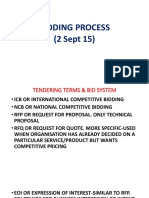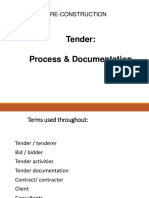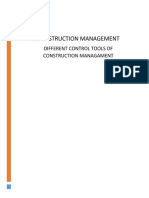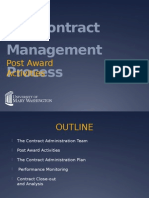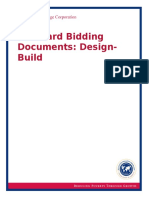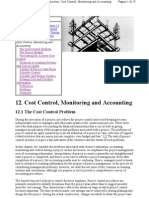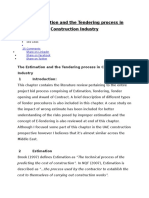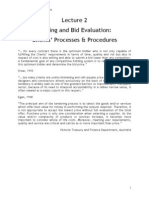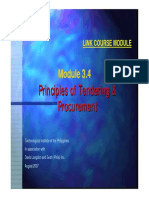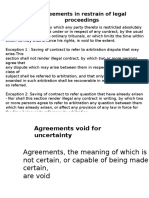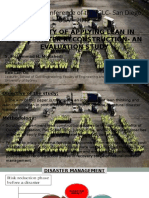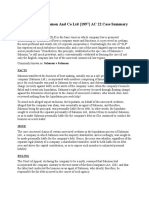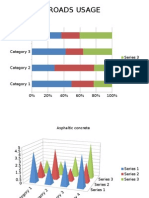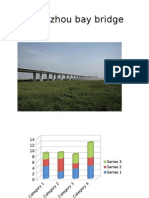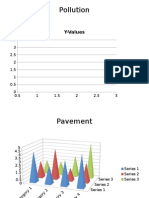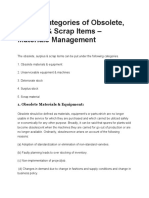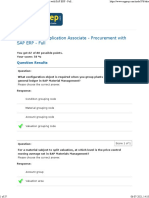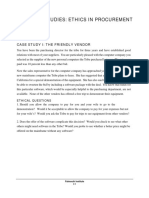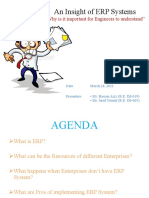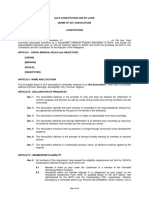Bidding and Bid
Evaluation
Clients Processes & Procedures
� for every contract there is the optimum bidder who is not only
capable of fulfilling the Clients requirements in terms of time,
quality and risk but also in respect of cost is also willing and able
to submit a bid lower than any competitor. A fundamental goal of
any competitive bidding system is to reveal the identity of this
optimum bidder and determine the bid price.
too many clients are undiscriminating and still equate price
with cost, selecting designers and constructors almost exclusively
on the basis of tendered price. This tendency is widely seen as
one of the greatest barriers to improvement. The public sector,
because of its need to interpret accountability in a rather narrow
sense, is often viewed as a major culprit in this respect.
�Procurement Objectives
�Procurement Strategic Importance
The introduction of leading edge concepts, for example, best practice
benchmarking, total quality management and supply chain concepts etc.;
Technological complexity resulting in specialisation requiring organization to
purchase goods from those with specialist expertise;
Central & State government policies & legislations;
Increasing recognition of the finite nature of resources;
Increasing proportion of revenue spent externally;
Fewer but larger suppliers; and
Increasing environmental awareness.
�Procurement objectives
Purpose of procurement - meet the user's requirement
Requirement - specific level of quality or standard of
service (need, cost-effectiveness and affordability)
Expressed in terms of output and performance (to avoid
favouritism)
Specified by reference to recognized standards, where
relevant, making provision for equivalents
To purchase the right quality of material, at the right time,
in the right quantity, from the right source, at the right
price
�Quality/Product
Is defect free on delivery/completion
Has a reasonably efficient running cost
Has satisfactory durability
Is aesthetically pleasing
Has undergone value analysis/engineering
Is innovative that is, it incorporates original design quality
Is subject to satisfactory guarantees and after sale service
�Time/programme
Timely delivery/completion
Certainty of completion date and other time related
estimates
Early commencement of work/fabrication/manufacture
Design proposals to be submitted expeditiously
Rapid rectification of defects
�Cost
Certainty of cost estimates
Value for money
Ease of accountability
Competition lowest possible tender
Obtaining cost certainty or reduction in risk of cost
overrun
Realistic maintenance and running costs
�General issues
The desire to be actively involved and informed during
the life of a project
A clear allocation of responsibilities/single-point
responsibility
Flexibility to change design during production
The need for positive and constructive advice from
consultants/ Contractors
Fully motivated and co-operative project team no
conflict.
�An alternative approach
To supply the organization with a steady flow of materials and services to meet its needs.
To ensure continuity of supply by maintaining effective relationships with existing
sources and by developing other sources of supply either as alternatives or to meet
emerging or planned needs.
To buy efficiently and wisely, obtaining by an ethical means the best value for every
pound spent.
To manage inventory so as to give the best possible service to users at lowest cost.
To maintain sound co-operative relationships with other departments, providing
information and advice as necessary to ensure the effective operation of the organization as
a whole
To develop staff, policies, procedures and organization to ensure the achievement of
the foregoing objectives
�An alternative approach
To select the best suppliers in the market.
To help generate the effective development of new products.
To protect the company's cost structure.
To maintain the correct quality/value balance.
To monitor supply market trends.
To negotiate effectively in order to work with suppliers who will seek
mutual benefit through economically superior performance
�Emerging procurement themes
Competition
Best value/value for money
Value analysis/engineering
Legal obligations
�Procurement Policies
�Purchasing Decision Making
Make or buy decision making
Subcontracting - ability to do a job; capacity, expertise, time,
specialization
Buying commodities
Capital goods
Purchasing for resale
Buying services
Outsourcing core/ non-core activities
Buying internationally
�Procurement Systems, Policies & Ways
In-house project
Be available full-time
Be the single-point contact for the organization
At the very least be able to answer all incoming questions fully and promptly
Understand and organize the internal decision-making processes required for the project
Have the power to speak and act for the organization
Act in support of any external project leadership appointment
Project management
Consultant advisers
Complementing skills available within the client organization
Supplying impartial advice on the need (or not as the case may be) to build and how to go
about building
�Procurement Routes
Design and Construct
Design and build
Direct
Competitive
Develop and construct/manufacture 2 stage
Package deal standardised/ semi standardised product
Turnkey single administrative entity
Private Finance Initiative (PFI) - The promoter designs, builds, finances and operates
the facility on behalf of the (public) client
Build-Own-Operate-Transfer (BOOT) - private client provides and operates a facility on
behalf of a (usually) public client for a fixed term & then transfers (BOO, DBFO)
Design and manage requires specialist contractors (Contractor, Consultant)
Maintenance & Operation special cases!
�Separate Design and Construct
Traditional Form Measurement Criteria (Item Rates/
Lumpsum)
Sequential Design
Accelerated Design
Management methods
Management contracting
Construction management
Prime cost contracting - single point of responsibility (the
Prime Contractor) between the client and his sourced supply chain
�Alternatives
Partnering
Organizations agree to work together for a period of time, perhaps unspecified, on a basis of mutual trust and with
common objectives thereby optimising each partner's strengths
partners still maintain a sense of independence with their own contractual arrangement and a tendering process
that may or may not be based on a competitive/cost structure.
involves a client buying a product (the project) through a procurement process that may involve any one of many
forms (traditional, negotiated price, design and build, management contracting etc.). Partnering, and its
advantages, lies in attitudes and behaviours governing a commercial process.
Alliancing
More all encompassing
Virtual company merger
trustworthy, committed and world-class professional and competent firms join with the owner/client to develop the
project
Risk and reward sharing
Framework agreements
Term contracting - executed over a given time period (generally for repair and maintenance)
e-Procurement
�Procurement Assessment Criteria,
Assessment Models
�Bid Classification
Prequalifying proposals - requests for information, qualifying
statements and capacity statements
Unsolicited proposals - preliminary proposals, feasibility studies and
design studies
Informal proposals - offer letters and presentations
Formal tenders - sealed bids, budgetary proposals, negotiated
tenders, open tenders, selective tendering and single action tenders
�Tendering
�Tendering - advantages
Achieve a better idea of the right price from a range of
suppliers and are better able to make an informed
judgement upon which to select.
Specify closely what they need from the product and
allow the manufacturers to interpret those needs and
put a price against them.
Gains an objective assessment, which they can review
and audit.
Gain an understanding of the quality that the supplier
can achieve and within what time-scale.
�Tendering - Disadvantages
The cost and involvement of the client are high in producing the specification and tender
documents.
Fully specified tender documents restricts value engineering/ innovation.
Loosely specified tender documents may result in diverse solutions varying in price and content.
Suppliers could quote too high, too low leading to dispute or failure of supply (performance,
support or maintenance), supplier defunt.
The procedures for tendering are often slow. Acceleration results in low, poor or no responses
Lowest price- lack of performance and quality of supply.
Tendering procedures may be expensive to set up tender charges
Tendering can be unsuitable for some types of contract/low value. For example, single supplier
of the product or service required
Contractors declining tender to avoid alienating a client or consultant - through artificially high
price.
�Types of Bids
Open
Closed
Negotiated
�Bidding procedures - Phases
Identify the problem area and the possible requirement
Develop plans to provide the solution
Assess potential solution providers - Prequalification
Decide upon the tendering method
Prepare tender documents, technical and commercial specifications
Invite suppliers to tender and issue tender documents
Receive suppliers' tenders and proposals
Evaluate the responses
Negotiate with the preferred supplier(s)
Award the contract to the winning bidder
�Prequalification
Financial standing and record
Recent similar building experience speed, costs, time
General experience, skill and reputation in the area
Adequacy of technical and management structure for contract
type
Competence and resources wrt EHS
Approach to quality assurance systems
Adequate capacity at the relevant time
�Tender Staging
Single stage tenders
Two stage tenders
Formal presentations
Award criteria
�Good tendering Practices
Commitment: Clients initiate projects, set the style and tone and are essential team members .
Role definition: clients need to define their own role and equip them to carry it out. For example,
client involvement in the design and management of projects requires appropriate resourcing and
expertise.
Realism: priorities and expectations, for example, time frame and price, should be realistic and
fair.
Briefing: a clear brief is essential to establish exactly what is required, including the level of
service, specification or product .
Negotiate: a willingness to negotiate with consultants, contractors and suppliers.
Variations: restrict variations in design, specification or product to the essential. If
changes are necessary a systematic approach is crucial.
Communication: communicate expectations both internally and externally. Ensure there is
a clear chain of communication and decision-making avoid confusion by communicating
via a single voice
�Fair Tendering
Select advisers and consultants after careful consideration.
Select an appropriate procurement methodology that best fits the projects priorities.
Adopt and adhere to fair tendering procedures that include:
The publication of procurement contact points, making available as much information as tenders
need to respond to the bidding process;
The preparation of appropriate tender documentation;
The identification and selection of an appropriate number of suitable tenders;
An appropriate period of time for the preparation of tenders;
A method of dealing with errors within the tender documentation;
A consistent procedure for the submission and inspection of tenders;
A method for dealing with errors within tenders;
The provision of feedback to all tenders on the outcome of bids promptly and, within the bounds of commercial
confidentiality, to debrief winners and losers on request on the outcome of the bidding process to facilitate better
performance on future occasions;
The application of the highest professional standards in the management of contracts; and
Procedures to respond to suggestions, enquiries and complaints; and
Prompt payment procedures.
�Bid Evaluation
�Bid Evaluation Criteria Development stages
definition of the technical requirements: product characteristics,
cost tolerances, make or buy decisions, the demand for the company's
own products, the competitive environment in which the organisation
operates.
assessment of potential suppliers: technical support/back up, the
availability of financial credit services, geographical proximity, the
competence of the supplier in purchasing, manufacturing and
distribution, the supplier's delivery record and the past quality of the
firm's performance
bidding negotiations: the characteristics of each individual offer
including the price, delivery, quality and the vendor rating reached
during the assessment of the supplier
�Evaluation Methods
"Weighted point plan
Categorical approach
Risks, Value and Security
Value
Security - Routine order products, Procedural problem
products, Performance problem products, Political
problem products
�Understanding Customer (Buying Centre)
Height: the number of levels in the organisation (its hierarchy) that exert an
influence on the buying centre.
Width: the number of functional areas or departments that are involved in the
buying decision.
Depth: the total number of people involved in the buying decision
Factors
1. Understanding the business environment in which customers operate
2. Understanding each customer's mission, objectives and markets
3. Understanding the decision-making process each customer makes when purchasing a
product/service
4. Understanding the factors the customer considers when purchasing a product/service
5. Understanding the roles played by those individuals involved in making the purchase
6. Understanding the customer's communication network
�Evaluation Criteria
Technical
Commercial
Financial
Generally, in two/three envelope bids, Contractors who pass the technical
evaluation only, shall become eligible for Commercial/ and or Financial Bid
Opening
�Technical Criteria
performance and productivity standards
quality
inspection requirements
operational and maintenance costs
professional competence
technical/professional support
standardisation
after-sales service
cost and availability of spares and/or consumables
provision of manuals and training
sample testing
warranties
�Commercial Criteria
compliance with the invitation to tender including:
acceptance by the tenderer of the purchasers terms and conditions of
contract
compliance with delivery requirements
compliance with tender validity period
acceptance of payment arrangements
ownership e.g. in the case of a training course
length of time that product range/design will be on the market
�Financial Criteria
life cycle costing comparisons (where appropriate)
quantifiable financial risks/ benefits from technical evaluation
fixed or variable pricing
cost of components, spare parts, consumables and servicing
financial qualifications to fulfil the contract
Adjustment for foreign currency and exchange risks
risk analysis and financial appraisal
cost of variations/additions to the product/service (costs of
changing/adding?)
�Further reading
Appendices of lecture Bid & Bid Evaluation.pdf
Page 339 of Commercial Management David Lowe
Chapter 15- Claims Management Construction Cost Management
through Case Studies Keith Potts

